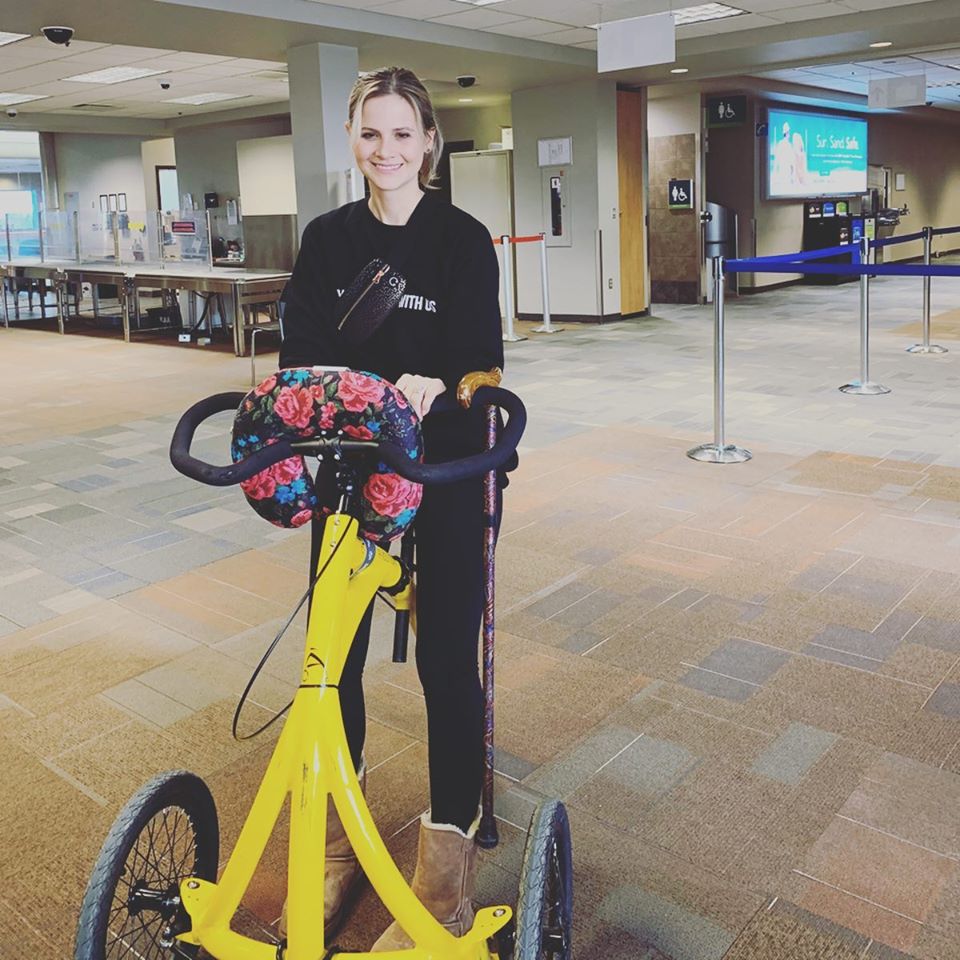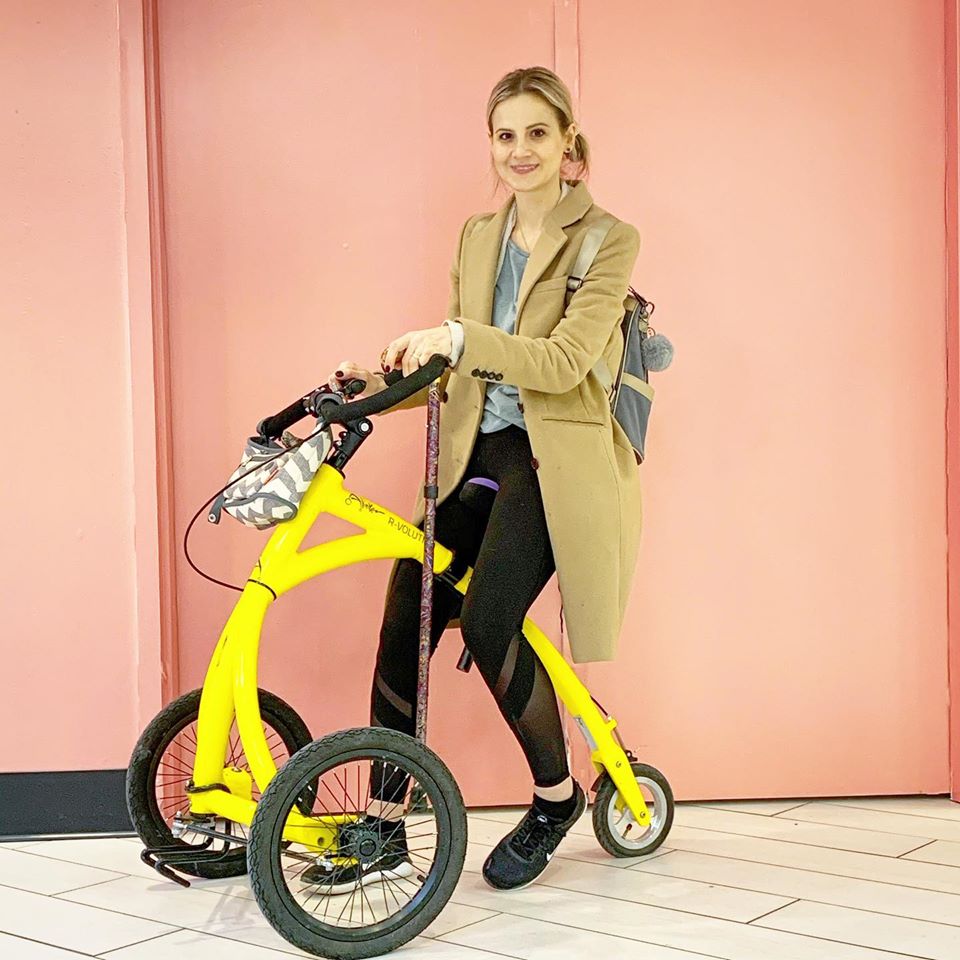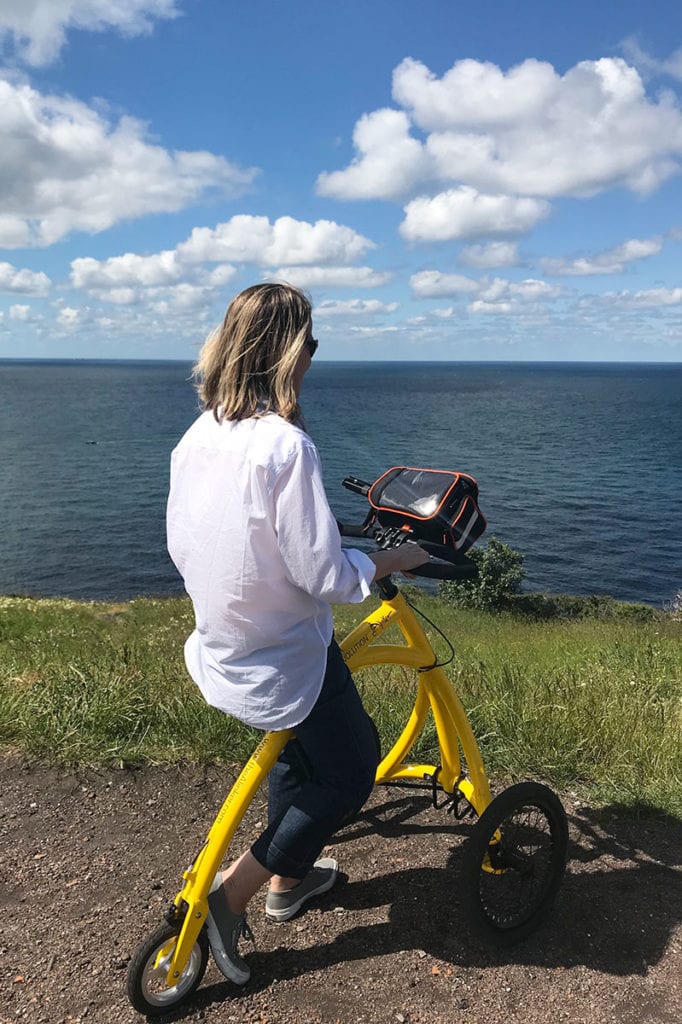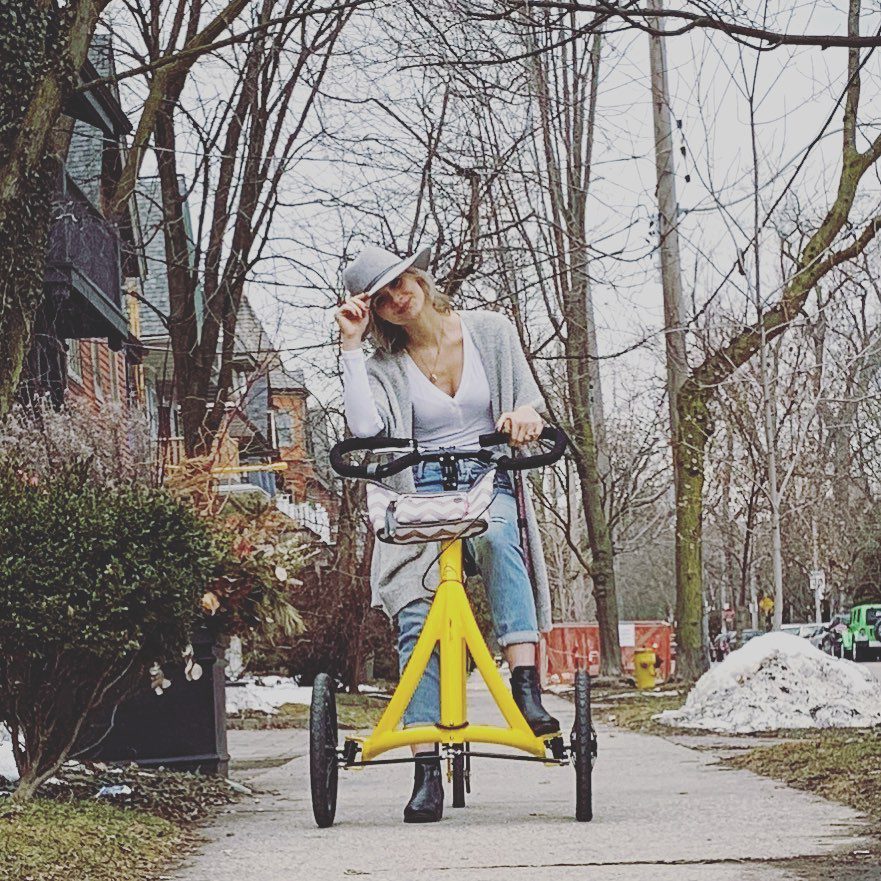Last updated on March 20th, 2022
Making Travel Easier with the Alinker Bike
By Kat Inokai, Guest Writer
As someone who depends on mobility aids, I still get anxious getting ready to run local errands let alone contemplating travel. My mind buzzes with questions like ‘is the location I’m going to really accessible?’, ‘what if their elevator is under repairs’ and about a million more. Travel only intensifies this anxiety, but recently I’ve found a more confident approach thanks to my ALinker.
The gorgeous yellow walking bike hit the North American market in 2016 but truly burst onto the scene last year with actress Selma Blair hailing it a game-changer to help with her MS-related mobility issues. It’s now making international waves with its positive impact on disabled and ageing communities, as well as for those simply looking to keep an active lifestyle.
What makes it so special? The ALinker’s seated design offers the same core support that a wheelchair may provide for ambulatory wheelchair users, but also allows users to keep their legs active– and its eye-level design keeps one socially engaged as well.
As a disabled mom of two who has multiple autoimmune conditions and has relied on mobility aids for the last two years, I can safely say that in the six months since Barbara (BE) Alink dropped one of her beautiful yellow inventions off at my home, my life has changed drastically. I have become more physically active, my world became more accessible, and my wanderlust is back with a vengeance.

Of course, I still felt the flutter of first-time nerves when the family and I took my ALinker to the airport for a 10-day trip. Even with reassurance from BE herself, my anxiety surged as we got to the terminal. ‘What if someone says I can’t gate check my ALinker? What if no one believes that it’s my walk-assist?’ I had so many concerns running through my head – and while sadly, they were validated by the discrimination so many like me face on a daily basis – I also knew I wouldn’t feel more confident or empowered until I could answer every one of those questions and more with firsthand experience.
I’m so glad I got on that plane.
Here are my top tips for empowered travel with the ALinker, my favourite yellow vehicle for change.

Connect with the community for support, before you travel
The ALinker community is incredibly engaged and ready to help. They are active on social media, a strong hashtag following (#Alinkerfamily) and a private Facebook group reserved specifically for current ALinker users and their families. This has helped me connect with other ALinker users in your area, meet new friends, and get experience-based travel advice about accessible travel from all over the world – wherever there’s wifi.
Know your rights
As someone navigating travel through the lens of disability, I find it is so important to know your human rights and to feel confident and calm while advocating for yourself. Currently, the ALinker is a sensational pop of colour and design not often seen by airline staff and security. Even in the face of novelty, there are rules as to how people can ask you about any assistance, and your disability. In Canada, no one can ask you outright if you are disabled, and no one has the authority to deny you your assist. Although I have been asked ‘wow, what is that?’ or ‘is that a scooter?’ in a kind tone by airport security and air carrier staff, I have simply responded ‘It’s my walk assist’ and that is that – unless we end up engaged in a pleasant conversation about how cool it is.


Give yourself time
Rushing while you travel is probably one of the most stressful experiences. The more time I take to plan, the more confident and prepared I feel with my ALinker – and with any other mobility aid! At the time of booking your ticket, contact the airline that you are travelling with and inquire about assistance through the pre-board screening, or getting extra help to board the plane.
At least 2-3 weeks before, reach out to your doctor, specialist, or treatment representative to ensure they can provide you with any supporting letters you may need for security screening.
On the day of travel, make sure to treat local flights like international (add two hours to boarding time), and add another two hours to international flights. I would rather have too much time enjoying a coffee or filming an Instagram story at the gate, than missing a flight because of a security check backlog.
At security checkpoints, I assume I’ll need extra time to show documentation, explain my equipment, or experience delays trying to find someone who will translate my document. If you have a specialty implant or medical equipment that prevents you from going through a metal detector or being hand-wanded, give yourself extra time to go through a physical search. Security screening might also include an inspection of your Alinker and gathering an explosive trace sample from the seat. This in itself might not take a long time, but it might take a few extra minutes to get off and back onto your ALinker.
Do some trial runs
Practice folding your ALinker up for storage at gate check or for any car travel that you might need once you arrive at your destination and have anyone travelling with you do the same. Not only will this give you the confidence and speed of familiarity but will also help you explain how to break it down to, for example, an Uber driver who needs to take the wheels and seat off to fit it in his sedan trunk. Doing this kind of a dry run will help me navigate the storage of any accessories that I am using while travelling, including baskets, caddies, cup holders, quadlock, and more.



Carry tools, just in case
Travel tends to invite adventure, so whether a wheel goes flat, or you find yourself in a sudden snowstorm, it’s great to be prepared just in case. I have learned to carry or have access to a small bicycle wheel pump, a wheel patch or bike repair kit, and a small tube of axle / white grease which stops the axles from rusting if you take your ALinker out in the snow. Hey, you never know!
Gauge your endurance
The ALinker can be a bit of a workout! I was shocked by my ‘jelly legs’ the first few times I dismounted, so when we decided to bring it as my main walk-assist for 10 days on a trip to Saskatchewan, I made sure that I did more than a few walks around the block to get ready. I spent more time using my Alinker at home as I was cooking to prepare for possible queues and wait times, and I also practiced going up and down small inclines to strengthen my muscle engagement. Each person’s strength, reflexes and physical condition are going to be different, but even with my practice, I was caught off guard by the ramp of the passenger boarding bridge. Although my kids thought that me zooming past them yelling ‘maaaaake waaaaaaay’ was highly entertaining, I made a mental note to get a little more practice with inclines and hills to be ready for airports and travel adventure alike.


Know that you are a conversation starter
Whether it’s the sunny stream-lined design of the ALinker or the huge smile it seems to put on its user’s faces, it tends to be a magnet for curious onlookers. My experience is that many of those who approach an ALinker are seeing it as a life-changing solution for themselves or a loved one, and that makes conversations incredibly different from the often invasive and offensive questions like ‘what happened to you?’ that mobility aid users are all too familiar with. This can be a fantastic icebreaker if you are travelling, but if – like me- you have conditions that can suddenly deplete your energy, it’s good for you and a travel companion to have a few easy go-to responses.
If I am too tired to chat about my ALinker or listen to the often fascinating and sometimes very intimate personal stories about illness or disability of those that feel pulled to it, my husband jumps in and says ‘it’s her walk assist, isn’t it great? – please feel free to take a picture, but we’re going to keep moving now’. I also just left BE Alink a voice message about an idea I had for a scannable QR code sticker, or even a card to hand out during travel to make connecting with ALinker fans and potential ALinker family members even easier.
While BE Alink didn’t reinvent the wheel, she certainly changed accessibility as we know it with the ALinker. Now, whether I’m going to the corner store or boarding a plane, I feel the ALinker community behind me, and travel opportunities fanning out into my future.
Adventure awaits.
Want to read more about Accessible Travel?
You’ll love Elizabeth’s story of travelling in Scandinavia!




I haven’t received mine yet. This information is great. Thank you.
I am very interested in this walk assist,
I would like more information on this product.
I am eagerly awaiting my Alinker! I have a question if you don’t mind. When you fly, and check your Alinker is it checked at the check in desk or can you check it in at the airplane door? Do you take any special care to protect it?
I have enjoyed your videos! Thank you, Joy Boren
Received my Alinker today can you supply a drink bidden also a basket for the handle bars
Will be flying and going on cruise in Feb. Thank you for this info!
Please I need to get a travel bag for the A-Linker!! Or how to?!